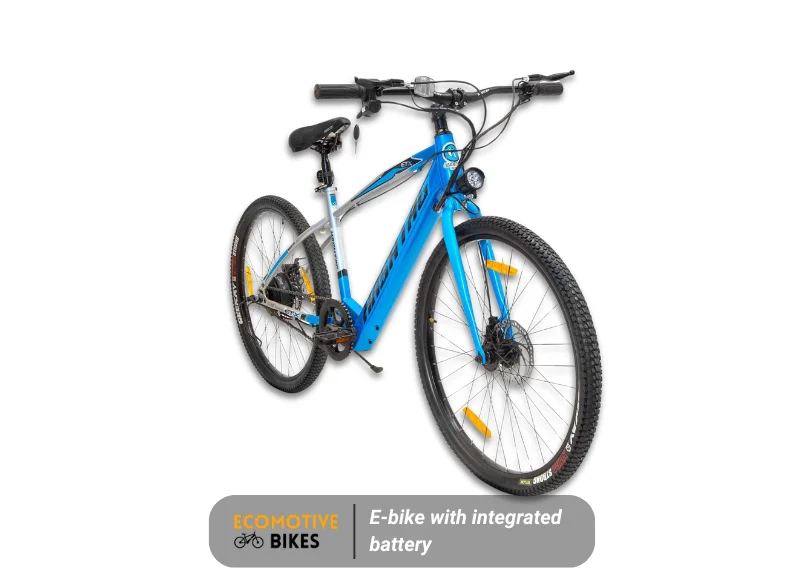Integrated vs. Removable electric bike battery
Integrated vs. removable electric bike battery: Explore the differences in design, convenience, and performance to determine which battery type best suits your e-bike needs.
Table of Contents
Related Articles:
“Integrated vs removable electric bike battery, which is best for an e-bike?” This question is bound to come into the mind of every e-bike buyer. And why won’t you? After all, deciding between an integrated or removable battery is crucial for any prospective e-bike owner. So, at ecomotobike.com, we came up with a vivid difference between the two battery types that tell the merits and demerits of both.
So, e-bike enthusiast here is the in-detail study of integrated vs. removable electric bike batteries.
What are integrated batteries?
Integrated batteries are built-in power sources designed to fit seamlessly within the frame of electric bikes or other devices. Unlike removable batteries, they are housed inside the structure, offering a sleek design, better weight distribution, and protection from external elements. This integration enhances aesthetics and reduces the risk of theft.
The integrated design is quite advantageous. It enhances e-bike’s aesthetics. It offers a clean, streamlined look that closely resembles a traditional bicycle. Plus, it provides superior protection to the battery. Encased within the frame, the battery is shielded from the elements, reducing the risk of damage from rain, dust, and other environmental factors. This, in turn, can contribute to extended battery life and overall bike longevity.

Characteristic of integrated e-bike battery
The prime characteristics of integrated e-bike battery are as follows:
- Sleek design: Integrated batteries create a clean, streamlined aesthetic by hiding the battery within the frame, making the e-bike look more like a traditional bicycle.
- Enhanced security: Since they are not easily removable, integrated batteries deter theft, as they are more difficult to steal or tamper with.
- Improved durability: The enclosed design offers superior protection from the elements (rain, dust, wind) which can damage batteries.
- Reduced charging wear: There is less risk of damage to the charging connection because the battery doesn’t need frequent removal.
- Limited range: Integrated batteries often have a fixed capacity, potentially limiting how far you can travel on a single charge.
- Inconvenient charging: The bike needs to be parked near a power source to charge, which may not always be feasible.
- Difficult replacement: Replacing an integrated battery is typically more complex and expensive than a removable one.

Advantages of integrated e-bike batteries
Though removable batteries are the most preferred, integrated batteries come with their benefits. Here are its 7 benefits:
- The sleek and streamlined design creates a classic bike look.
- Discourages theft due to being permanently fixed.
- Needs low maintenance.
- Dirt and dust protection adds to the extended battery life.
- The design offers resistance to weather effects.
- Easier charging with guaranteed access to a power source.
- Lightweight design with minimal weight impact on the e-bike.
Drawbacks of built-in batteries
Here are the three major drawbacks of the built-in batteries:
- Fixed-capacity batteries may restrict travel distance on a single charge.
- Replacing an integrated battery is often more complex and expensive.
- Proximity to a power source where access to an outlet may be restricted becomes a crucial drawback during charging.
What is a removable e-bike battery?
The most-opted removable batteries also known as portable batteries are designed to be detached from the e-bike frame. This battery comes in two main configurations: front-frame mounted batteries, offering a more balanced weight distribution, and rear-rack mounted batteries, which can sometimes free up frame space for additional cargo.
This battery type offers greater versatility and convenience like charging at any standard power outlet and swapping out for a fully charged one, extending your ride without waiting for a recharge.
Characteristics of removable battery
Removable batteries come with their set of characteristics, which are as follows:
- Design: Removable batteries are either placed on the front frame as a detachable front frame or at the back as the detachable rear rack.
- Aesthetics: Traditionally, removable batteries were larger and more visible, potentially detracting from the overall visual appeal of the e-bike. However, advancements in design have led to the creation of sleeker, more streamlined batteries that minimize this aesthetic impact.
- Convenient charging: Because it is detachable, removable batteries offer ultimate charging flexibility. They can be charged on or off the e-bike into any outlet at home, work, or even a charging station during your travels.
- Effortless replacement: Unlike integrated batteries, removable options are easy to swap out without any technical expertise. You need to carry a spare battery and effectively double your riding range on longer trips.
- Lightweight replacement: Carrying a spare battery can never pose an issue. The spare batteries are typically lightweight. They weigh around 1.26kg.
- Vulnerable to security and theft: The unavailability of the lock mechanism and the ease of removal make them more susceptible to theft compared to integrated batteries.
- Exposure to weather extremities: The visibility of the battery and its removable design leaves both the battery and the electrical components exposed to the weather and environmental harshness.

Benefits of detachable e-bike battery
Removable batteries are popular which owes to their benefits. Here are the 5 benefits of a detachable e-bike battery:
- Offer unparalleled charging versatility at any standard power outlet at home, work, or even during leisure activities.
- Eliminates the need to move the entire e-bike for charging, maximizing convenience and integration into daily routines.
- Removable batteries can be effortlessly swapped out without requiring any specialized technical knowledge.
- Empowers riders to carry a spare battery, effectively doubling their potential travel range on extended journeys.
- Replacement batteries are typically lightweight and readily available for purchase. They weigh around 1.26kg.
Cons of removable battery
Besides the pros, removable batteries have a few disadvantages, listed below.
- Detachable nature poses a greater security risk compared to integrated alternatives.
- Traditionally, removable batteries have been larger and more visible, potentially detracting from the e-bike’s overall design.
- Not all removable batteries incorporate locking mechanisms, further elevating their susceptibility to theft.
- The visibility of the battery and it’s removable design leaves both the battery and the electrical components exposed to the weather and environmental harshness.
Which is the best e-bike battery-integrated or replaceable?
Selection between integrated and removable batteries boils down to your personal needs and how you envision using your e-bike daily. Integrated batteries offer a clean look and enhanced security, ideal for those who prioritize convenience and peace of mind.
However, if charging flexibility and maximizing range are your top concerns, a removable battery e-bike might be the better fit. Weighing the advantages and disadvantages of each type will help you find the perfect e-bike companion for your daily rides.
Final Word: Integrated vs. Removable electric bike battery
From above, it is evident that the choice between integrated and removable electric bike batteries ultimately comes down to personal preference and lifestyle. Integrated batteries offer a sleek, secure, and weather-resistant option, while removable batteries provide convenience, flexibility, and easier replacement.
Riders should consider factors such as aesthetics, security, charging convenience, and environmental protection when making their decision. Ultimately, both types of batteries have their own set of advantages and disadvantages, and the best choice will depend on individual needs and priorities.
Find more resources about electric bike batteries here.





